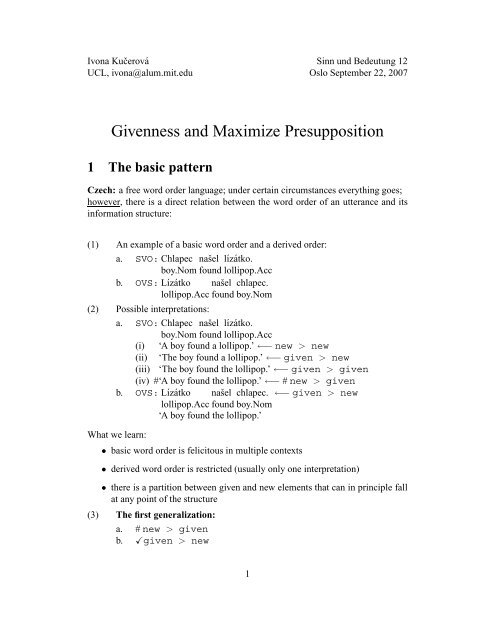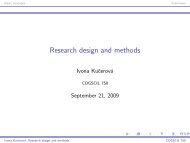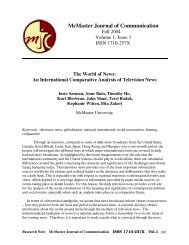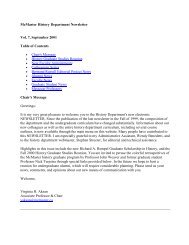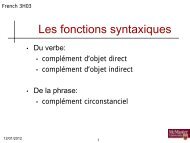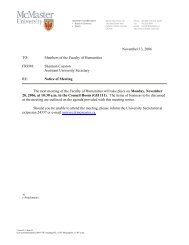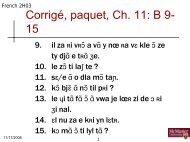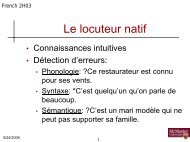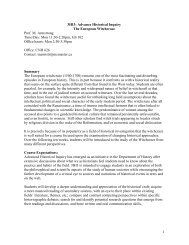handout
handout
handout
You also want an ePaper? Increase the reach of your titles
YUMPU automatically turns print PDFs into web optimized ePapers that Google loves.
Ivona Kučerová<br />
UCL, ivona@alum.mit.edu<br />
Sinn und Bedeutung 12<br />
Oslo September 22, 2007<br />
Givenness and Maximize Presupposition<br />
1 The basic pattern<br />
Czech: a free word order language; under certain circumstances everything goes;<br />
however, there is a direct relation between the word order of an utterance and its<br />
information structure:<br />
(1) An example of a basic word order and a derived order:<br />
a. SVO: Chlapec našel lízátko.<br />
boy.Nom found lollipop.Acc<br />
b. OVS: Lízátko našel chlapec.<br />
lollipop.Acc found boy.Nom<br />
(2) Possible interpretations:<br />
a. SVO: Chlapec našel lízátko.<br />
boy.Nom found lollipop.Acc<br />
(i) ‘A boy found a lollipop.’ ←− new > new<br />
(ii) ‘The boy found a lollipop.’ ←− given > new<br />
(iii) ‘The boy found the lollipop.’ ←− given > given<br />
(iv) #‘A boy found the lollipop.’ ←− # new > given<br />
b. OVS: Lízátko našel chlapec. ←− given > new<br />
lollipop.Acc found boy.Nom<br />
‘A boy found the lollipop.’<br />
What we learn:<br />
• basic word order is felicitous in multiple contexts<br />
• derived word order is restricted (usually only one interpretation)<br />
• there is a partition between given and new elements that can in principle fall<br />
at any point of the structure<br />
(3) The first generalization:<br />
a. # new > given<br />
b. ̌given > new<br />
1
Ivona Kučerová<br />
UCL, ivona@alum.mit.edu<br />
Sinn und Bedeutung 12<br />
Oslo September 22, 2007<br />
BUT: not every word order is possible with a particular interpretation:<br />
(4) e.g., if the object and the verb are given and the subject is new:<br />
a. ̌O V S<br />
b. # V O S<br />
(5) The second generalization:<br />
In a given context and with a particular interpretation, there is only one<br />
felicitous order.<br />
(6) The third generalization:<br />
An utterance maybe be divided into domains. Within any domain there can<br />
be a partition between given and new.<br />
−→ domains correspond to chunks that have been argued to be propositional<br />
(7) a. Do you know anything about Petr and Marie?<br />
b. Náhodou jsem slyšel, že Petrovi<br />
accidentally Aux.1sg heard that Petr.Dat<br />
Marii | zaměstnali v ABB.<br />
Marie.Acc employed.1pl in ABB<br />
| říkala<br />
told<br />
nějaká<br />
some<br />
paní,<br />
lady<br />
že<br />
that<br />
‘I accidentally heard that some lady told Petr that Marie got employed<br />
in the ABB.’<br />
(8) a. Do you know what Mary did with her famous boat?<br />
b. Marie | se pokusila lod’ | prodat.<br />
Marie REFL tried boat to-sell<br />
‘Marie tried to sell the boat (but no one wanted to buy it).’<br />
c. Marii | nařídil soud lod’ | prodat.<br />
Marie.Dat ordered court.Nom boat.Acc to-sell<br />
‘(You won’t believe it but) a court ordered Marie to sell the boat.’<br />
−→ a rather complex data pattern that so far has not been properly characterized<br />
Desiderata:<br />
• to characterize the word order restriction and its relation to information structure<br />
• to explain it<br />
2
Ivona Kučerová<br />
UCL, ivona@alum.mit.edu<br />
2 Existing proposals<br />
Sinn und Bedeutung 12<br />
Oslo September 22, 2007<br />
The Prague school:<br />
an old tradition going back to the beginning of the 20th century (Mathesius’ Prague<br />
lectures, 1908; Mathesius [1929] 1983; Daneš 1954; Firbas 1964; Sgall et al. 1980,<br />
among others):<br />
• any utterance is divided between a given and a new part (topic – focus, theme<br />
– rheme)<br />
A modern way to read Mathesius:<br />
• anything can be chunked into partitions<br />
• the partition may fall at any place<br />
• accounts for ambiguity of certain strings<br />
Limitations:<br />
• cannot account for restrictions on word order within a given or new chunk<br />
(any word order should go as long as there is a partition)<br />
• cannot account for the domains (minor point: this could be accommodated)<br />
Cartographic approaches (Rizzi, 1997, 2004, among others):<br />
• there is a designated functional projection on the main sentential spine: if an<br />
item is to be interpreted as given/new it must move to the projection<br />
Limitiations:<br />
• cannot account for restrictions on word order within a given or a new part<br />
• the fact that the partition can fall at any point is unexpected<br />
• cannot account for cases where the partition is not on the main spine – and<br />
yet the partition is relevant for the main spine:<br />
(9) Yesterday Marie | and Paul came to school.<br />
Yesterday<br />
Marie<br />
and<br />
Paul<br />
came to school<br />
3
Ivona Kučerová<br />
UCL, ivona@alum.mit.edu<br />
3 The proposal<br />
Sinn und Bedeutung 12<br />
Oslo September 22, 2007<br />
Basic intuition:<br />
structures are divided into domains and any domain can be partitioned at any position<br />
within the domain [this we learned from basic word orders] (≈ Mathesius’<br />
tradition)<br />
−→ there is a point in the structure from which everything up is given<br />
A formalization: G(iven)-operator<br />
−→ an operator that marks elements in its scope as given; the operator recursively<br />
propagates upwards and it terminates on an atomic semantic type – in our case on<br />
type t (or < s, t >) [a simplifying assumption]<br />
(10) G-operator:<br />
G(B) =<br />
{ λA α : Given(A).G(B A) B is of type < α, β > for some α, β<br />
other than s, t<br />
B for B of type < s, t ><br />
(11) < s, t ><br />
given<br />
given<br />
G<br />
new<br />
new . . .<br />
What the G-operator does for us:<br />
• once the operator starts propagating upwards it doesn’t stop unless it reaches<br />
the edge of a domain → structures are divided into domains in which given<br />
precedes new<br />
• the operator can be inserted at any place → a partition can fall at any place<br />
A note on interpretation of givenness: For concretness, I follow Sauerland (2005)<br />
in assuming that givenness gives rise to an existential presupposition (cf. Schwarzschild<br />
1999). My interest lies in how givenness applies compositionally, the actual lexical<br />
entry is not crucial.<br />
4
Ivona Kučerová<br />
UCL, ivona@alum.mit.edu<br />
Sinn und Bedeutung 12<br />
Oslo September 22, 2007<br />
−→ this is how we get the interpretation and the partitions in a basic word order but<br />
what happens if only the object is given and the subject and the verb are new?<br />
(12) Only object is given (S V | O):<br />
Option I: G operator inserted on O:<br />
< s, t ><br />
subject<br />
verb<br />
object<br />
G . . .<br />
−→ Presupposition failure<br />
As we have seen in (2), the word order must change:<br />
(13) S V O → O G V S<br />
BUT: why do we need to change the order? Why can’t we simply omit the operator?<br />
−→ violation of Maximize presupposition (Heim, 1991; Sauerland, 2007):<br />
(14) Maximize Presupposition<br />
In context C used the most informative presupposition satisfied in C.<br />
−→ the only way to resolve the conflict between Maximize Presupposition and Presupposition<br />
failure is to reorder the structure (cf. Wagner 2005, To appear b)<br />
Question: why is not movement always possible?<br />
−→ independent restrictions on syntactic movement (Minimize Move) (for further<br />
details see Kučerová 2007):<br />
• syntactic restrictions on movement (e.g., Path Containment of Pesetsky 1982)<br />
• economy condition on movement: movement is licensed only if it gives rise<br />
to an otherwise unavailable interpretation Reinhart, 1995, 2006; Fox, 1995,<br />
2000<br />
5
Ivona Kučerová<br />
UCL, ivona@alum.mit.edu<br />
4 Interim summary<br />
Sinn und Bedeutung 12<br />
Oslo September 22, 2007<br />
The ingredients of the proposal:<br />
• Independently motivated from other areas:<br />
– Maximize Presupposition<br />
– Presupposition Failure<br />
– economy condition on Move<br />
• A new component:<br />
– the G-operator<br />
Two basic situations:<br />
• I: Basic word order: we plug in a G-operator that marks everything upwards<br />
as presupposed<br />
• II: if there is given below new we must reorder – only then a G-operator can<br />
be inserted<br />
−→ movement arises as a solution to a conflict between Maximize Presupposition<br />
and Presupposition Failure<br />
A side-note: If a language does not have a recursive G-operator, for example English,<br />
this type of conflict does not arise and reordering is not expected.<br />
The rest of the talk:<br />
• more on domains<br />
• further predictions<br />
• Appendix: the evaluation component<br />
6
Ivona Kučerová<br />
UCL, ivona@alum.mit.edu<br />
5 Establishing the domains<br />
Sinn und Bedeutung 12<br />
Oslo September 22, 2007<br />
Prediction: If the G-operator terminates on an atomic semantic type, given elements<br />
should gather on the closest left edge corresponding to an atomic type.<br />
Finite clauses correspond to propositions<br />
−→ prediction: given elements do not move out of a finite clause<br />
(15) For a long time I didn’t know what was going on with Mary. But then. . .<br />
a. mi Petr řekl, že Marii potkalo velké štěstí.<br />
me Petr.Nom told that Marie.Acc met big happiness<br />
‘Peter told me that Marie got extremely lucky. (She won a lottery.)’<br />
b. #Marii mi Petr řekl, že potkalo velké štěstí.<br />
Marie.Acc me Petr.Nom told that met big happiness<br />
Infinitives correspond to proposition (in a technical sense; there is no tense)<br />
−→ prediction: given elements do not move out of infinitival domains<br />
(16) What happened to the antique chair you got many years ago from Mary?<br />
a. Petr se pokusil / chtěl / dokázal tu židli<br />
Petr REFL tried wanted managed that chair<br />
‘Petr tried/wanted/managed to burn the chair.’<br />
b. #Tu židli (se) Petr pokusil / chtěl / dokázal<br />
that chair (REFL) Petr tried wanted managed<br />
‘Petr tried/wanted/managed to burn the chair.’<br />
spálit.<br />
burn.Inf<br />
spálit.<br />
burn.Inf<br />
Analytic versus synthetic tense formation: different tenses in Czech have different<br />
morphological formation ( Present is synthetic (finite verb) but Future is analytic<br />
(auxiliary + infinitive))<br />
−→ prediction: assuming that a tense auxiliary selects for a proposition, there is a<br />
difference in locality of movement of given elements between the Present tense and<br />
the Future tense<br />
(17) Present: given elements move to the left edge<br />
a. What is happening to the book?<br />
b. Tu knihu | dává Marie Petrovi. ← synthetic<br />
the book.Acc gives Marie.Nom Petr.Dat<br />
‘Marie gives the book to Petr.’<br />
7
Ivona Kučerová<br />
UCL, ivona@alum.mit.edu<br />
Sinn und Bedeutung 12<br />
Oslo September 22, 2007<br />
(18) Future: given elements may move only locally:<br />
a. What will happen to the book?<br />
b. Marie bude tu knihu dávat<br />
Marie.Nom will the book.Acc give.Inf<br />
‘Marie will give the book to Peter.’<br />
c. #Tu knihu bude Marie dávat<br />
the book.Acc will Marie.Nom give.Inf<br />
‘Marie will give the book to Peter.’<br />
Petrovi. ← analytic<br />
Petr.Dat<br />
Petrovi.<br />
Petr.Dat<br />
Past: 3rd person versus 1st and 2nd person: in the Past tense, only 1st and 2nd<br />
person have an overt auxiliary, there is no auxiliary for 3rd person<br />
−→ prediction: given elements move further in sentences with 3rd person<br />
(19) 3sg.:<br />
(20) 1pl.:<br />
a. What happened to the boat that got demaged in the last storm?<br />
b. Lod’ opravil jeden technik.<br />
boat.Acc repaired one technician.Nom<br />
‘A technician repaired the boat.’<br />
a. What happened to the boat that got demaged in the last storm?<br />
b. Jeden technik a já jsme lod’ opravili .<br />
one technician.Nom and I Aux.1pl boat.Acc repaired<br />
‘A technician and I repaired the boat.’<br />
Small clauses correspond to propositions as well<br />
−→ prediction: given elements do not move out of small clauses<br />
(21) a. Why does Peter look so happy?<br />
b. Marie je na Petra pyšná<br />
Marie.Nom is of Petr proud<br />
‘Marie is fond of Peter.’<br />
c. #Na Petra je Marie pyšná.<br />
of Petr is Marie proud<br />
.<br />
Notice: All infelicitous examples with a fronted given element are grammatical but<br />
they mean something different (usually topic or contrastive reading); for example,<br />
Mary is fond of Peter, not of Bill., (21-c), or As to the chair, Peter wanted to burn it,<br />
but he definitely wanted to keep the table., (16-b)<br />
8
Ivona Kučerová<br />
UCL, ivona@alum.mit.edu<br />
6 Further predictions: Coordination<br />
Sinn und Bedeutung 12<br />
Oslo September 22, 2007<br />
Question: What happens if movement is not only disprefered but it is not allowed?<br />
−→ in the previous cases, Minimize move was a violable constraint: it was possible<br />
to violate it in order to resolve the conflict between Maximize Presupposition and<br />
Presupposition Failure – this is not an option anymore<br />
What do we expect:<br />
• either Maximize Presupposition or Presupposition failure will be violated<br />
• or there is another strategy that can be used to solve the conflict<br />
A case to look at: syntactic islands<br />
−→ the predictions are not easy to test because islands often coincide with an<br />
atomic type – we cannot be sure whether there is a G-operator that terminates on<br />
the edge of the island<br />
Exception: Coordination (because it preserves its type)<br />
Two cases to consider:<br />
• Case I: a coordination adjoined to an atomic semantic type<br />
• Case II: a coordination not adjoined to an atomic semantic type<br />
Prediction for case I:<br />
there should be no problem with a DP coordination if it is adjoined to an atomic semantic<br />
type (e.g., a coordinated subject) −→ the structure should be well formed as<br />
long as the given part of the coordination precedes the new part of the coordination:<br />
(22) Na programu byla diskuse o nové učitelce. context<br />
on program was discussion about new teacher<br />
‘The topic of the program was a discussion about a new teacher.’<br />
(23) Učitelku a (její) žáky to překvapilo. ←− ̌DP & DP<br />
teacher and her students it surprised<br />
‘The teacher and (her) students were surprised by it.’<br />
(24) #Žáky a učitelku to překvapilo. ←− # DP & DP<br />
students and teacher it surprised<br />
‘A teacher and (her) students were surprised by it.’<br />
9
Ivona Kučerová<br />
UCL, ivona@alum.mit.edu<br />
Sinn und Bedeutung 12<br />
Oslo September 22, 2007<br />
−→ notice that the right structure must be merged – it cannot be derived by movement<br />
−→ Question: how is the right structure selected? [appendix]<br />
Prediction for case II:<br />
unclear:<br />
• inserting a G-operator will necessarily lead to Presupposition failure:<br />
new<br />
given<br />
G and new<br />
new<br />
• if no G-operator is inserted the Maximize presupposition maxim will be violated<br />
What we find:<br />
(25) #To se nelíbilo ani učitelce ani žákům. ←− # new > DP & DP<br />
it REFL not-liked nor teacher nor students<br />
‘Neither a teacher nor students were happy about it.’<br />
Is there any way out? −→ the given element must be pronominalized:<br />
(26) a. To se nelíbilo ani jí ani žákům. ̌pronoun<br />
it REFL not-liked nor her nor students<br />
‘Neither she nor students were happy about it.’<br />
b. To se nelíbilo ani té učitelce ani žákům. ̌that DP<br />
it REFL not-liked nor that teacher nor students<br />
‘Neither the/that teacher nor students were happy about it.’<br />
Why should pronominalization be relevant?<br />
A proposal: If a lexical entry of α gives rise to a presupposition, there is no need<br />
to introduce the presupposition by the G-operator.<br />
There is still more to be discovered. . .<br />
10
Ivona Kučerová<br />
UCL, ivona@alum.mit.edu<br />
7 The evaluation component<br />
Sinn und Bedeutung 12<br />
Oslo September 22, 2007<br />
(27) Reference set for Maximize Presupposition evaluation<br />
For purposes of Maximize Presupposition, the reference set, toward which<br />
Maximize presupposition is evaluated, consists of all derivations<br />
a. that are based on the same numeration and free insertion of G-operator,<br />
and<br />
b. that make the same assertion.<br />
−→ the pronominalization cases teach us what must be in the reference set – a possibility:<br />
pronouns are DP ellipses (Elbourne, 2005), or pronouns are pronunciation<br />
of φ-features (cf. Heim To appear)<br />
Parameters of the evaluation:<br />
(28) SYNTAX:<br />
a. the reference set may contain only grammatically well-formed structures<br />
b. the optimal structure has the smallest number of movement necessary<br />
to obtain an otherwise unavailable semantic interpretation (Reinhart,<br />
1995; Fox, 1995, 2000; Reinhart, 2006)<br />
(29) INTERPRETATION:<br />
a. a presupposed element must be marked as given (either lexically or<br />
by a G-operator) [≈ Maximize Presupposition]<br />
b. a new element cannot be marked as given [≈ Presupposition Failure]<br />
References<br />
Daneš, František. 1954. Příspěvek k rozboru významové výstavby výpovědi [a<br />
contribution to the analysis of the semantic structure of the utterance]. Studie a<br />
práce lingvistické I:263–274.<br />
Elbourne, Paul D. 2005. Situations and Individuals. MIT Press.<br />
Firbas, Jan. 1964. On defining the theme in functional sentence perspective.<br />
Travaux linguistiques de Prague 1:267–280.<br />
Fox, Danny. 1995. Economy and scope. Natural language semantics 3:283–341.<br />
Fox, Danny. 2000. Economy and semantic interpretation. Cambridge, Mass.: MIT<br />
Press.<br />
11
Ivona Kučerová<br />
UCL, ivona@alum.mit.edu<br />
Sinn und Bedeutung 12<br />
Oslo September 22, 2007<br />
Heim, Irene. 1991. Artikel und Definitheit. In Semantik: Ein internationales Handbuch<br />
der zeitgenössischen Forschung, 487–535. Berlin: Mouton de Gruyter.<br />
Heim, Irene. To appear. Features on bound pronouns. In Phi-theory: Phi-features<br />
across modules and interfaces, ed. Daniel Harbour, David Adger, and Susana<br />
Béjar. Oxford University Press.<br />
Kučerová, Ivona. 2007. The syntax of givenness. Doctoral Dissertation, MIT.<br />
Mathesius, Vilém. [1929] 1983. Functional linguistics. In Praguiana: Some basic<br />
and well-known aspects of the Prague Linguistics School, ed. J. Vachek, 121–<br />
142. Amsterdam: John Benjamins.<br />
Pesetsky, David. 1982. Paths and categories. Doctoral Dissertation, MIT.<br />
Reinhart, Tanya. 1995. Focus – the PF interface [University of Utrecht, ms.].<br />
Reinhart, Tanya. 2006. Interface strategies. Optimal and costly computations. Cambridge,<br />
MA: MIT Press.<br />
Rizzi, Luigi. 1997. The fine structure of the left periphery. In Elements of grammar:<br />
Handbook of generative syntax, ed. Liliane Haegeman, 281–337. Dordrecht:<br />
Kluwer.<br />
Rizzi, Luigi, ed. 2004. The structure of CP and IP. The cartography of syntactic<br />
structures, volume 2. Oxford: Oxford University Press.<br />
Sauerland, Uli. 2005. Don’t interpret focus: Why a presuppositional account of focus<br />
fails, and how a presuppositional account of givenness works. In Proceedings<br />
of Sinn und Bedeutung 9, 370–384. University of Nijmegen, Netherlands.<br />
Sauerland, Uli. 2007. Implicated presuppositions. In Sentence and context, ed.<br />
Anita Steube. Berlin: Mouton de Gruyter.<br />
Schwarzschild, Roger. 1999. GIVENness, AvoidF and other constraints on the<br />
placement of accent. Natural language semantics 7:141–177.<br />
Sgall, Petr, Eva Hajičová, and Eva Buráňová. 1980. Aktuální ˇclenˇení vˇety v ˇceštinˇe<br />
[Topic/focus articulation of the Czech sentences]. Praha: Academia.<br />
Wagner, Michael. 2005. Prosody and recursion. Doctoral Dissertation, MIT.<br />
Wagner, Michael. To appear b. Givenness and locality. In Proceedings of SALT<br />
XVI. Ithaca, NY: CLC Publications.<br />
12


